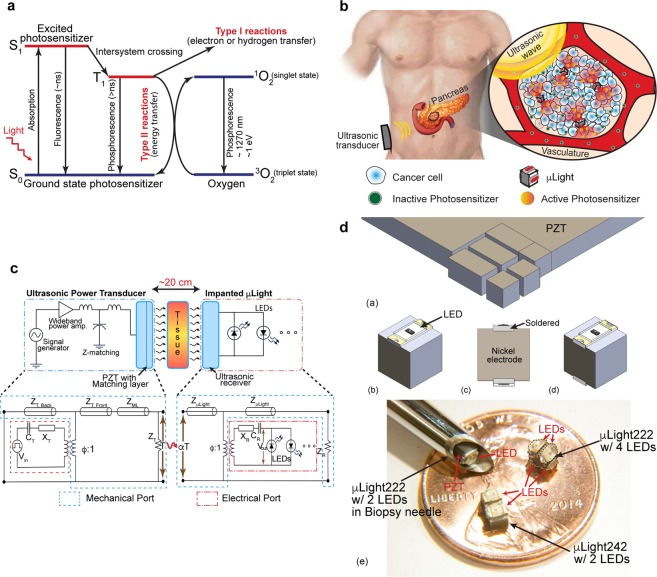Figure 1.
(a) Working mechanism of PDT: Light exposure excites the photosensitizer molecule from ground singlet state (S0) to an excited state (S1). The molecule in S1 may undergo intersystem crossing to an excited triplet state (T1) then either form radicals via Type 1 reaction or transfers its energy to triplet oxygen (3O2) to form a singlet oxygen (1O2), which is major cytotoxic agent via Type II reaction4,5. (b) Illustration of implantable µLight in a deep-seated tumor: ultrasonic waves applied from an external transducer travel through tissue to trigger light generation by the μLight, thus activating a pre-delivered photosensitizer, which in turn generates reactive oxygen species (ROS) to kill cancer cells. (c) Ultrasonic powering: Schematics of the power transfer link and its theoretical electromechanical model33 © 1999 IEEE. Reprinted, with permission, from Sherrit, S., Leary, S. P., Dolgin, B. P. & Bar-Cohen, Y. Comparison of the Mason and KLM equivalent circuits for piezoelectric resonators in the thickness mode. 1999 IEEE Ultrason. Symp. Proceedings, Int. Symp. (d) Fabrication process for the μLight: (a) dice PZT into 2 × 2 × 2 mm3 and 2 × 4 × 2 mm3 pieces, (b) solder one LED between the nickel electrodes, (c) solder another LED with reverse polarity on the opposite side (more LEDs can be soldered on the two remaining sides), (d) parylene-C coat the device for passivation, (e) optical photographs of fabricated prototypes.

